How To Add Shading To Drawings
Shading is the procedure of adding value to create the illusion of form, infinite, and most importantly - low-cal in a drawing. When executed correctly, shading tin can make a drawing appear three dimensional and create a convincing prototype.
When rendering a drawing that communicates book, shading is absolutely disquisitional.
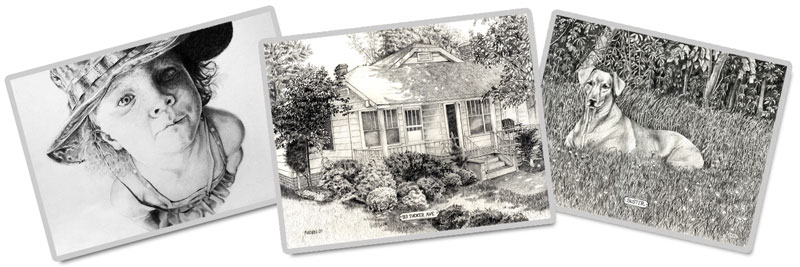
Shading Techniques for Drawing
Techniques used for applying shading to an object are quite varied. Each technique produces a different texture and "feel" to the drawing. The drawing medium used may determine the shading technique that is applied in the drawing.
The near common application techniques include:
Hatching - Lines fatigued in the aforementioned management. By drawing lines closer together, darker values are created. Leaving more space between lines results in lighter values. For rounded objects, the lines may curve slightly around the form - following the contours of the object.

Cantankerous-Hatching - Lines cross over each other. The density at which the lines cross over each other determines the value that is produced.

Blending - Smooth gradations of value are produced either past adjusting the amount of pressure level applied to the medium or by using a blending tool, such a blending stump.

Rendering - Using an eraser to remove the medium to produce lighter values. This technique is typically used in conjunction with blending.

Random lines - Loose applications of crossing lines. The frequency in which the lines cantankerous over each determines the value produced.

Stippling - Applying countless small-scale dots to build upward darker values in a cartoon. The density of the dots determines the value produced.

Come across ALSO : How to create polish shading with graphite
The Illusion of Light
It's easy to get defenseless up in the technique in which the material is practical and loose sight of the reason why we apply shading in the first place.
Low-cal is how nosotros come across, later on all, and shading informs united states of america of the lite within a scene. We empathise the light within the scene through the utilize of value and contrast.

Value is the darkness or lightness of a color. Light values are called tints and dark values are called shades.
Dissimilarity deals with difference. Contrast is produced when any difference between elements such as texture, color, size, or value occurs. Information technology tin be subtle or extreme. When it comes to shading, nosotros are mostly concerned with the contrast that is produced from changes in value.
When light hits the subject, information technology produces a range of contrasting values. The intensity of the low-cal determines the dissimilarity of values. Generally, the stronger the low-cal - the higher the contrast.
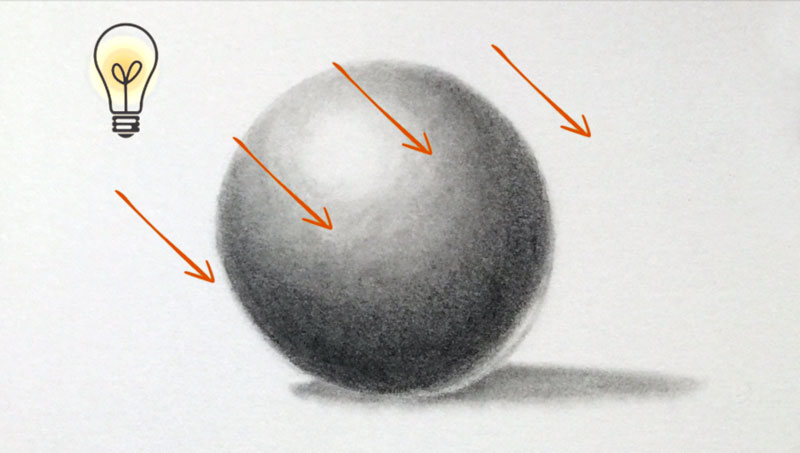
Values are arranged on the field of study according to the location and intensity of the light source (or sources). To simplify the fashion in which light behaves on a subject area and surrounding objects, nosotros'll look at what happens with only one light source on a smooth surface.
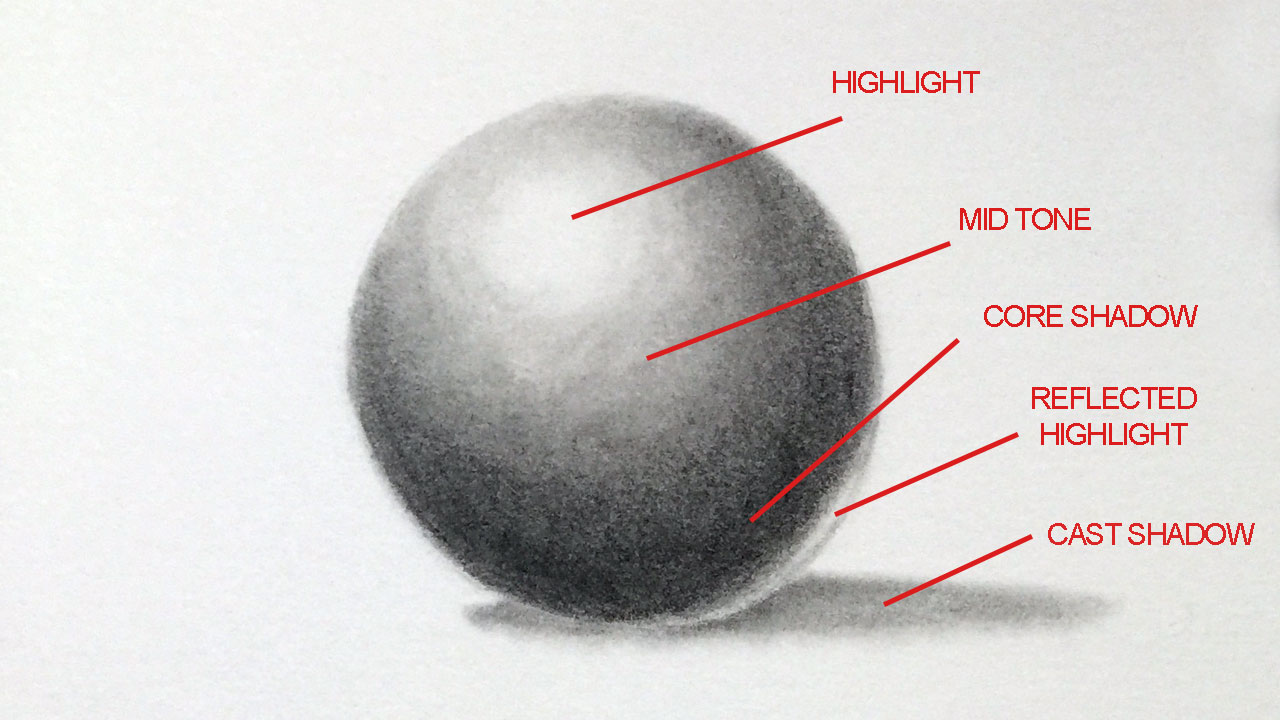
The locations of each surface area of value on the subject tell the viewer almost the location of light and how the light behaves on the subject. The behavior of low-cal (or how it is reflected) on the discipline informs us about the texture and form of the subject.
Locations of Value:
Highlight - The highlight is the location on the subject where the reflection of light is most intense. Highlights are typically indicated by a very calorie-free value of the color or in some cases - white.
Mid Tone - Mid tones are areas on the subject where some lite is hitting, but in a fashion that is less intense than the highlight. In many cases, the mid tone is the actual color (local color) or value of the subject field.
Core Shadow - The core shadow is the area on the bailiwick where light is prevented from striking, producing an area of shadow. Cadre shadows are typically darker values of the local color.
Bandage Shadow - Cast shadows are locations of darker value that effect on surrounding objects or surfaces. Lite is blocked from reaching these areas completely because another object is reflecting much of the calorie-free abroad.
Some light is reflected back off of surrounding objects and surfaces. This calorie-free bounces back onto objects producing an expanse of lighter value.
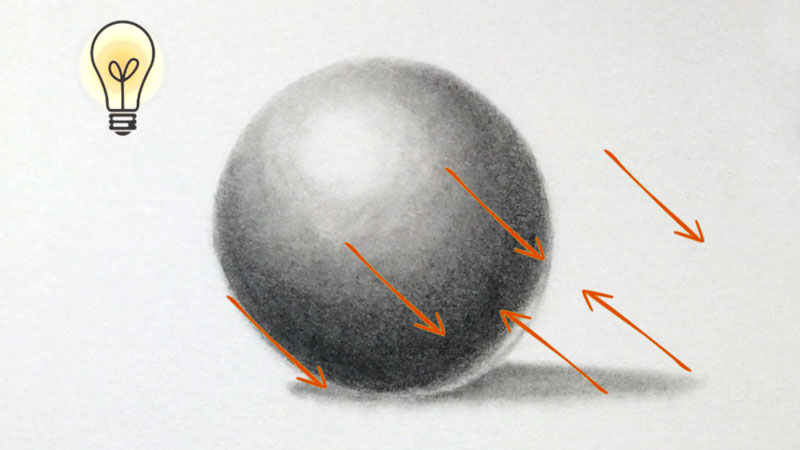
This area of slightly lighter value is referred to as a reflected highlight.
How to Shade Forms
As mentioned earlier, shading also informs the viewer of the form of the object. With a sphere, the modify in value is gradual (gradation). Value becomes darker or lighter, depending on the lighting conditions. The aforementioned is true for other curved forms such as cones or cylinders.
For objects with apartment sides (i.east. cube), the value stays fairly consequent for each side without much gradation. Each side of the cube may be a dissimilar value representing the highlight, mid tone, or core shadow.
But what almost objects that have flat sides or planes that aren't cubes?
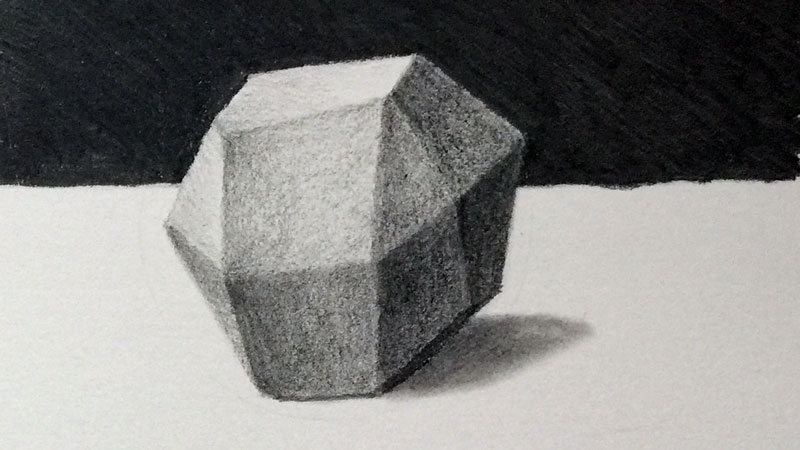
It is these situations where dissimilarity plays an especially important function.
When shading, our goal is to depict the illusion of course and lite. In almost situations, this requires adding a full range of value. By comparison contrasting areas, we can evaluate the value in the drawing and brand adjustments as necessary.
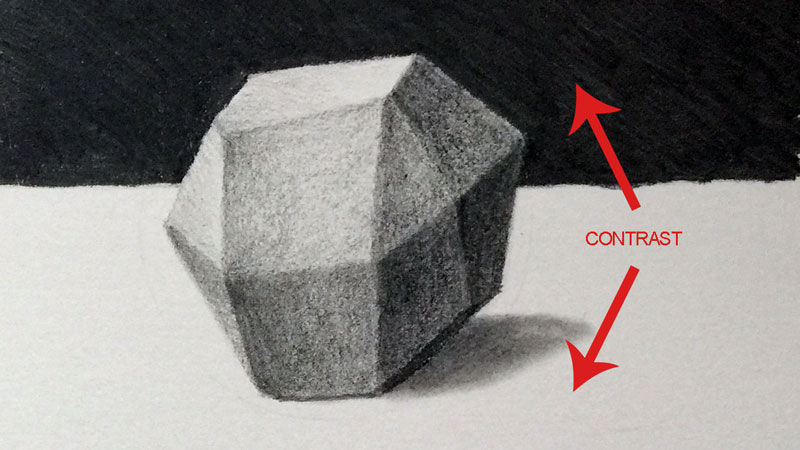
During the drawing process, a dark background is added. Adjustments to the values on the subject are made according to the contrast of values in the background and the table. Comparisons are fabricated and the values are "pushed" in guild to create a full range.
We can likewise exploit contrast to create edges and define the planes of the irregular form. By making the edges of each plane that are closer to the lite source "a bear on" lighter, we increment the contrast in value between each aeroplane.
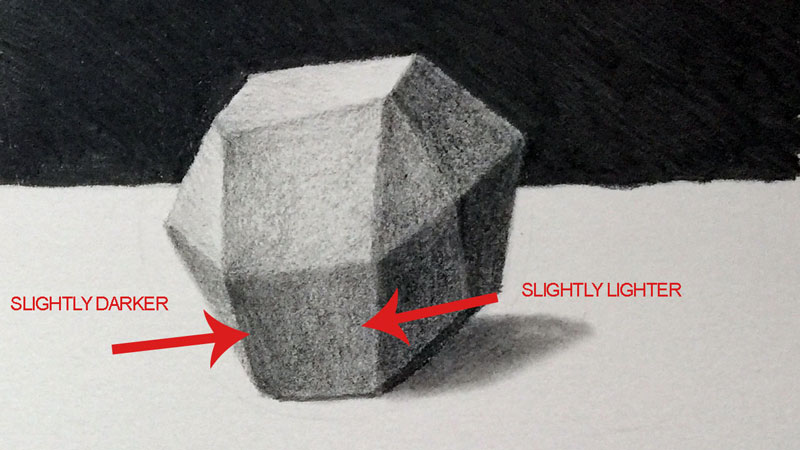

How to Shade Hollow Forms
Many objects are hollow or accept recesses. To address objects such every bit these, we simply consider the direction of light, thinking of it as a line.
If light is coming from a certain direction, then it should go on until it hits an object. If the object is hollow, and so the low-cal volition enter into the recess, producing an area of lighter value inside of it. Shadows are created on the opposite side of the edge of the recess, closest to the light source.
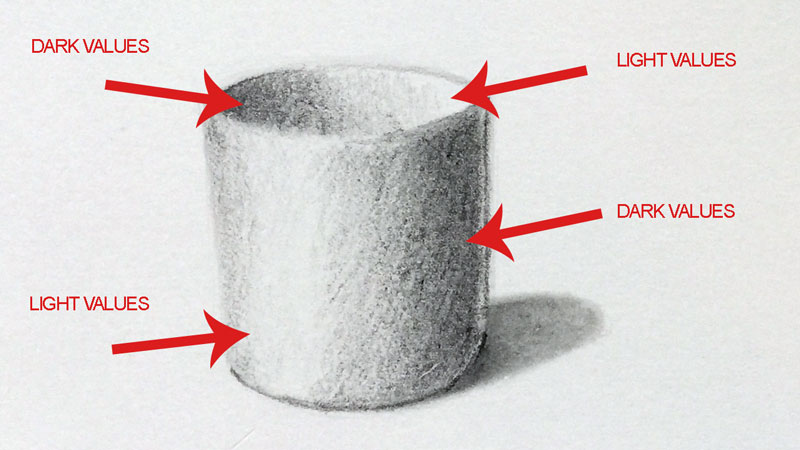
The exterior of the hollow grade is addressed equally normal, with shadows further from the light source and highlights close to information technology.
Decision-making the Medium
No matter which medium that you lot apply to employ shading, control over the value produced is of paramount importance. The good news is that control over the medium simply requires patience and practice.
One time you lot accept a clear understanding of how light behaves and how you can communicate it to the viewer, then you are already "half-manner" there.
Practice drawing a few basic forms - a sphere, cube, and pyramid. Shade them to communicate one light source using a full range of value. (Apply contrast to brand comparisons).
One time you have mastered these basic forms, move on to irregular forms and elementary still life objects like apples or bananas. Await for the highlights, mid tones, core shadows, cast shadows, and reflected highlights. The more than that you practice, the stronger y'all will go!
More than Lessons You'll Love...
How To Add Shading To Drawings,
Source: https://thevirtualinstructor.com/shading-techniques-basics.html
Posted by: stevensonnotheires.blogspot.com


0 Response to "How To Add Shading To Drawings"
Post a Comment